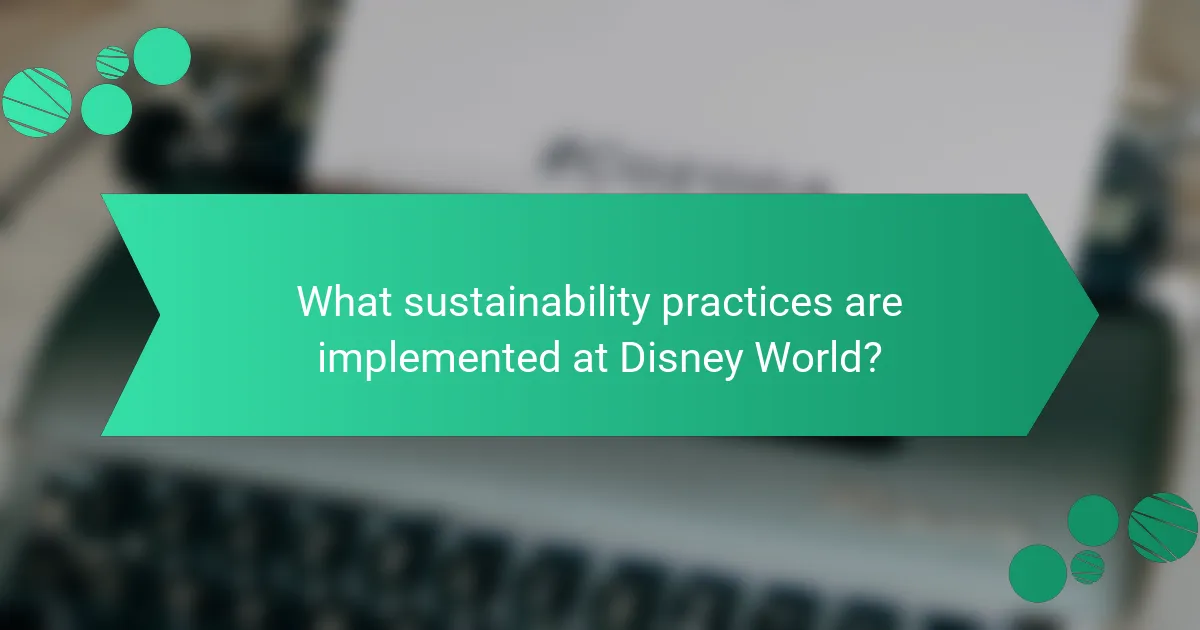
What are Disney World’s eco-friendly accommodations initiatives?
Disney World implements several eco-friendly accommodations initiatives. These include energy-efficient lighting in guest rooms and common areas. The resort also utilizes water conservation systems to reduce usage. Disney World promotes recycling and waste reduction throughout its facilities. Additionally, the use of sustainable materials in construction is prioritized. The resort’s commitment to sustainability is reflected in its landscaping practices, which favor native plants. Guest feedback highlights appreciation for these green initiatives. Overall, Disney World’s eco-friendly efforts contribute to a more sustainable tourism experience.
How has Disney World integrated sustainability into its accommodations?
Disney World has integrated sustainability into its accommodations through various eco-friendly initiatives. These include energy-efficient lighting and appliances in guest rooms. The resort also utilizes water conservation practices, such as low-flow fixtures. Additionally, Disney World has adopted recycling programs across its properties. The use of sustainable materials in construction is evident in new hotels. Disney’s commitment to reducing carbon footprints is reflected in its transportation options. Guest feedback highlights appreciation for these sustainable practices. Overall, Disney World aims to enhance the guest experience while promoting environmental responsibility.
What specific eco-friendly features are included in Disney World accommodations?
Disney World accommodations include several eco-friendly features. These features focus on sustainability and reducing environmental impact. Energy-efficient lighting is used throughout the properties. Water conservation systems are implemented in bathrooms. Recycling programs are established for guest waste. The use of eco-friendly cleaning products is standard. Some hotels utilize solar panels for energy. Many accommodations support local sourcing for food and supplies. Guests have reported positive experiences with these sustainable practices.
How do these features contribute to environmental sustainability?
The eco-friendly features at Disney World contribute to environmental sustainability by reducing resource consumption and minimizing waste. These initiatives include energy-efficient systems that lower electricity usage. For instance, solar panels installed across the resort generate renewable energy. Water conservation measures, such as low-flow fixtures, help reduce water usage significantly. Additionally, Disney’s recycling and composting programs divert waste from landfills. Guest feedback often highlights the importance of these sustainable practices. Studies show that eco-friendly accommodations can lead to a 20% reduction in overall environmental impact.
Why is sustainability important for Disney World?
Sustainability is important for Disney World because it enhances environmental stewardship and aligns with guest values. Implementing sustainable practices reduces the park’s ecological footprint. Disney World aims to achieve net zero greenhouse gas emissions by 2030. The park has invested in renewable energy sources, like solar power, to support this goal. Additionally, sustainable sourcing of materials minimizes waste and conserves resources. Guest feedback indicates a strong preference for eco-friendly initiatives. This commitment to sustainability strengthens Disney’s brand reputation and fosters community support.
What impact does Disney World aim to have on the environment?
Disney World aims to minimize its environmental impact through various sustainability initiatives. These initiatives include reducing greenhouse gas emissions and conserving water. Disney has committed to achieving net-zero greenhouse gas emissions by 2030. The park also focuses on waste reduction, aiming for zero waste in its operations. Disney World uses renewable energy sources, such as solar power, to support its energy needs. The resort has implemented water conservation measures, including smart irrigation systems. Additionally, Disney promotes eco-friendly transportation options for guests. These efforts reflect Disney’s commitment to environmental stewardship and sustainability.
How does Disney World’s sustainability commitment align with global trends?
Disney World’s sustainability commitment aligns with global trends by prioritizing renewable energy and waste reduction. The resort aims to achieve net-zero greenhouse gas emissions by 2030. This goal reflects the global shift towards climate action and sustainable practices. Disney has invested in solar energy, with a 270-acre solar facility generating enough power for two theme parks. Additionally, the company has implemented waste diversion programs, achieving a 60% diversion rate from landfills. These initiatives mirror worldwide efforts to reduce carbon footprints and promote sustainable tourism. Disney’s actions resonate with the increasing consumer demand for eco-friendly practices in travel and hospitality.

What sustainability practices are implemented at Disney World?
Disney World implements various sustainability practices. These include waste reduction, energy efficiency, and water conservation initiatives. The resort has a comprehensive recycling program that diverts a significant amount of waste from landfills. Disney World utilizes solar energy to power its facilities, with a large solar farm generating renewable energy. Water-saving technologies are installed in restrooms and landscaping. The resort also focuses on sustainable sourcing for food and merchandise. These efforts contribute to Disney’s goal of reducing its environmental footprint. Disney World’s initiatives are part of a broader commitment to sustainability across all its parks and resorts.
How does Disney World manage waste in its accommodations?
Disney World manages waste in its accommodations through a comprehensive recycling and waste reduction program. The resort implements a single-stream recycling system, allowing guests to dispose of recyclables easily. It also utilizes composting for organic waste generated in dining facilities. Disney World emphasizes waste diversion, aiming to reduce landfill contributions significantly. The resort has set a goal to achieve zero waste to landfills by 2030. These practices are part of a broader sustainability initiative, which has garnered positive feedback from environmentally conscious guests. The program is regularly evaluated for effectiveness and improvements based on guest input and sustainability goals.
What recycling programs are in place for guests and staff?
Disney World implements multiple recycling programs for both guests and staff. These programs include designated recycling bins placed throughout the parks and resorts. Guests are encouraged to recycle paper, plastic, and metal materials. Staff members are trained on proper recycling practices to ensure compliance. The resort also conducts educational campaigns to raise awareness about recycling. In 2020, Disney reported recycling over 50% of its waste. This commitment reflects Disney’s broader sustainability goals.
How does waste reduction contribute to sustainability goals?
Waste reduction significantly contributes to sustainability goals by minimizing resource consumption and reducing environmental impact. It decreases the amount of waste sent to landfills, thereby lowering greenhouse gas emissions. For instance, the U.S. Environmental Protection Agency reports that reducing waste can decrease methane emissions, a potent greenhouse gas. Waste reduction also conserves natural resources, as less material extraction is needed for production. This aligns with sustainability principles by promoting efficient resource use. Furthermore, implementing waste reduction strategies can lead to cost savings for businesses and consumers alike. These savings can then be reinvested in sustainable practices, creating a positive cycle.
What energy-saving initiatives are part of Disney World’s accommodations?
Disney World implements several energy-saving initiatives in its accommodations. These initiatives include the use of energy-efficient lighting throughout the hotels. Additionally, many rooms feature programmable thermostats to optimize heating and cooling. Disney World also utilizes water-saving fixtures to reduce overall water consumption. Solar panels are installed in some areas to harness renewable energy. The resort promotes recycling and waste reduction practices among guests. Furthermore, Disney World has committed to reducing greenhouse gas emissions in its operations. These measures contribute to the overall sustainability goals of the resort.
How does Disney World utilize renewable energy sources?
Disney World utilizes renewable energy sources primarily through solar power and energy efficiency initiatives. The resort has invested in large-scale solar farms, including a 270-acre solar facility that generates 50 megawatts of energy. This facility powers two of the parks and contributes to overall energy needs. Additionally, Disney has implemented energy-efficient technologies in its buildings and attractions. These efforts have led to a significant reduction in greenhouse gas emissions. In 2020, Disney announced a commitment to achieve net zero greenhouse gas emissions by 2030. This commitment is part of their broader sustainability strategy, which includes reducing waste and conserving water.
What technologies are used to enhance energy efficiency?
Smart thermostats optimize heating and cooling in accommodations. These devices learn guest preferences and adjust settings automatically. LED lighting reduces energy consumption significantly compared to traditional bulbs. Solar panels harness renewable energy, decreasing reliance on fossil fuels. Energy-efficient appliances use less power while maintaining performance. Building automation systems monitor and control energy use effectively. Insulation technologies minimize heat loss, enhancing overall efficiency. These technologies contribute to Disney World’s sustainability goals and improve guest experiences.

How do guests perceive Disney World’s eco-friendly initiatives?
Guests generally perceive Disney World’s eco-friendly initiatives positively. Many appreciate the commitment to sustainability. The implementation of recycling programs and waste reduction strategies is well-received. Initiatives like solar energy usage and water conservation efforts enhance guest satisfaction. Surveys indicate that eco-conscious visitors feel more inclined to support brands with green practices. Guests often express admiration for Disney’s efforts in preserving natural habitats. Positive feedback highlights the importance of environmental awareness in the overall experience. Disney’s eco-friendly measures contribute to a favorable image among visitors.
What feedback do guests provide regarding eco-friendly accommodations?
Guests often provide positive feedback regarding eco-friendly accommodations. They appreciate the commitment to sustainability. Many guests note the use of renewable energy sources. They value initiatives like recycling programs and water conservation efforts. Guests frequently mention the availability of organic and locally sourced food options. They also express satisfaction with eco-friendly amenities, such as biodegradable toiletries. Feedback indicates that guests feel a sense of responsibility when staying in green accommodations. Overall, many guests are willing to pay a premium for eco-friendly options.
How does guest feedback influence Disney World’s sustainability practices?
Guest feedback significantly influences Disney World’s sustainability practices. Disney actively collects guest input through surveys and social media. This feedback helps identify areas for improvement in eco-friendly initiatives. For example, guests have expressed interest in reducing plastic waste. In response, Disney has implemented measures to eliminate plastic straws and stirrers across its parks. Additionally, guest suggestions have led to the expansion of recycling programs. Disney also uses feedback to enhance energy efficiency in its accommodations. By aligning sustainability efforts with guest preferences, Disney fosters a more environmentally conscious experience. This approach has resulted in increased guest satisfaction and loyalty.
What common themes emerge in guest reviews about sustainability?
Common themes in guest reviews about sustainability include appreciation for eco-friendly practices. Guests frequently highlight the use of renewable energy sources. Many reviews mention water conservation efforts in accommodations. Guests also value the availability of recycling programs on-site. Positive feedback often notes the use of sustainable materials in construction. Guests appreciate educational initiatives about wildlife and conservation. Many reviews emphasize the importance of locally sourced food options. Overall, guests express a desire for continued commitment to sustainability efforts.
What are the challenges faced in implementing eco-friendly practices?
Implementing eco-friendly practices faces several challenges. One significant challenge is the higher initial costs associated with sustainable materials and technologies. For instance, eco-friendly building materials often have a premium price. Another challenge is the need for extensive employee training on new sustainable practices. Without proper training, staff may struggle to adhere to eco-friendly protocols. Additionally, there may be resistance from guests who are accustomed to traditional practices. This resistance can hinder the adoption of new sustainable initiatives. Regulatory compliance also poses a challenge, as eco-friendly practices must align with local laws and regulations. Furthermore, measuring the effectiveness of these practices can be complex, as it requires comprehensive data collection and analysis. Lastly, maintaining consistency in eco-friendly initiatives across all operations can be difficult, especially in large organizations like Disney World.
How does Disney World address guest concerns about sustainability?
Disney World addresses guest concerns about sustainability through various eco-friendly initiatives. The resort has implemented a comprehensive sustainability program focusing on waste reduction, energy efficiency, and water conservation. For instance, Disney World has committed to reducing greenhouse gas emissions by 50% by 2020 compared to 2012 levels. The park also utilizes solar energy, with a 270-acre solar facility that powers a portion of its operations. Additionally, Disney World has introduced a recycling program that diverted over 50% of its waste from landfills in recent years. The resort actively seeks guest feedback on its sustainability practices through surveys and social media channels. This feedback helps Disney improve its initiatives and align them with guest expectations.
What lessons has Disney World learned from guest feedback on eco-friendly initiatives?
Disney World has learned that guests prioritize sustainability in their experiences. Feedback indicates a strong desire for more visible eco-friendly practices. Guests appreciate initiatives like waste reduction and energy efficiency. They also want clear communication about these efforts. Surveys show that guests are willing to support businesses that prioritize the environment. Disney has responded by enhancing recycling programs and reducing plastic use. They have also increased plant-based dining options based on guest preferences. This feedback loop helps Disney align its initiatives with guest expectations.
What practical tips can guests follow to support sustainability at Disney World?
Guests can support sustainability at Disney World by following several practical tips. They should use reusable water bottles to reduce plastic waste. Utilizing the park’s refill stations helps minimize single-use plastics. Guests can also opt for digital tickets and maps to decrease paper usage. Choosing plant-based meal options contributes to lower carbon footprints. Guests should recycle items in designated bins throughout the park. Utilizing public transportation options, like buses and the monorail, reduces vehicle emissions. Participating in eco-friendly tours or experiences promotes awareness of conservation efforts. Lastly, guests can support local artisans by purchasing sustainable souvenirs. These actions collectively contribute to Disney’s commitment to sustainability.
Disney World is implementing various eco-friendly accommodations initiatives aimed at promoting sustainability and reducing environmental impact. Key practices include energy-efficient lighting, water conservation systems, recycling programs, and the use of sustainable materials in construction. Guest feedback highlights appreciation for these efforts, with positive responses regarding renewable energy usage and eco-friendly amenities. The resort’s commitment to achieving net-zero greenhouse gas emissions by 2030 aligns with global sustainability trends, reflecting a strong focus on environmental stewardship and responsible tourism.